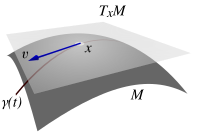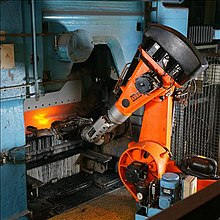Yaw, pitch, and roll
Yaw, pitch, and roll, also known as Tait–Bryan angles, named after Peter Guthrie Tait and George Bryan, are a specific kind of Euler angles very often used in aerospace applications to define the relative orientation of a vehicle. The three angles specified in this formulation are defined as the roll angle, pitch angle, and yaw angle.
Yaw, pitch and roll in aerospace


Yaw, pitch and roll are used in aerospace to define a rotation between a reference axis system and a vehicle-fixed axis system.
Consider an aircraft-body coordinate (XYZ) system which is fixed to the vehicle (rotates and translates with the vehicle). The origin of the XYZ system is located at the vehicle's center of gravity such that the X-axis points forward along some convenient reference line along the body (the roll axis), the Y-axis points to the right of the vehicle along the wing (the pitch axis), and the Z-axis (the yaw axis) points downward to form an orthogonal right-handed system. Consider a reference frame xyz that shares the same origin as the XYZ system but will be considered fixed in the discussion below. Keeping the plane example in mind, it can be imagined that it will always be aligned having x pointing in the direction of true north, y pointing to true east, and the z-axis pointing against the center of gravity of the earth.
Given this definition, the rotation sequence from xyz to XYZ is defined as follows:
- Right-handed rotation about the z-axis by the yaw angle.
- Right-handed rotation about the new (once-rotated) y-axis by the pitch angle.
- Right-handed rotation about the new (twice-rotated) x-axis by the roll angle.
This rotation sequence use a new reference frame for each successive rotation, and thus, each rotation associated with each step can't be expressed as a simple rotation matrix about a single axis. However, the above sequence is equivalent to doing a:
- Right-handed rotation , the roll angle, about the x-axis.
- Right-handed rotation , the pitch angle, about the y-axis
- Right-handed rotation , the yaw angle, about the z-axis.
These previous steps can now be respectively expressed as , and , where , , represent rotation matrices of an angle about the axes x, y and z respectively.
These rotations can then be combined successively by matrix multiplication to get a resulting single rotation matrix to apply to the object:
- ,
where denotes the change of coordinate matrix from basis xyz to basis XYZ.
If represents a column vector expressed in basis xyz, then accordingly we have
- .
Since a rotation matrix is orthogonal, the inverse rotation, from XYZ to xyz, is just the transpose of :
The matrix have thus for components
where and denote and , respectively.
It can be noted that sometimes the names yaw, pitch and roll refer to the three Tait-Bryan angles[1] or rotations with regard to a fixed reference frame, while sometimes, they are used to describe rotations (or motion) about the local reference frame of the aircraft, called the aircraft principal axes[2][3][4].
To understand the distinction in the usage of this terminology, one can picture a space shuttle in the xyz frame above, in its initial position as described, that is, nose pointing towards +x-axis, center of gravity at origin, and wings level with the xy-plane. If we specify a single Tait-Bryan roll angle with regard to xyz, the shuttle is now described as having tilted wings with regard to the xy-plane. The space shuttle could then be imagined to start a rotating motion about its wings-axis. This later motion could be described as pitching, but it is not a rotation about any of the xyz axes since the term now refers to the local reference frame of the shuttle.
Yaw, pitch and roll in navigation

In maritime navigation only the yaw angle is important. In fact, the word has a nautical origin, with the meaning of "bending out of the course". Etimologically, it is related with the verb 'to go'[5]. It is typically assigned the shorthand notation .[6]

It is defined as the angle between a vehicle's heading and a reference heading (normally true or magnetic North).
When used over the earth surface in long distances, the orientation of reference frame used depends on the latitude and longitude, and it is usually defined on the tangent space of the earth at that point, using as tangent vectors the derivatives of the lines of coordinates.
Given the difficult problem of follow a geodesic course, sailors used to follow lines of constant yaw at sea, called Rhumb lines or Loxodromes. On a Mercator projection map, a loxodrome is a straight line; beyond the right edge of the map it continues on the left with the same slope.
Given the spherical geometry of the surface of earth, some unexpected effects as parallel translation can happen.
Yaw, pitch and roll in robotics

These three angles are also used in robotics for speaking about the degrees of freedom of a wrist. It is also used in Electronic stability control in a similar way.
The importance of non-singularities in robotics has lead the American National Standard for Industrial Robots and Robot Systems — Safety Requirements to define it as “a condition caused by the collinear alignment of two or more robot axes resulting in unpredictable robot motion and velocities”. (ANSI/RIA R15.06-1999)
It is common in robot arms that utilize a “triple-roll wrist”. This is a wrist about which the three axes of the wrist, controlling yaw, pitch, and roll, all pass through a common point.
An example of a wrist singularity is when the path through which the robot is traveling causes the first and third axes of the robot’s wrist to line up. The second wrist axis then attempts to spin 360° in zero time to maintain the orientation of the end effector. Another common term for this singularity is a “wrist flip”. The result of a singularity can be quite dramatic and can have adverse effects on the robot arm, the end effector, and the process.
See also
References
- ^ Stevens, B. and Lewis, F. Aircraft Control and Simulation, 2nd Edition. Wiley-Interscience; 2 edition, October 6, 2003 [1]
- ^ NASA definition for Yaw motion http://www.grc.nasa.gov/WWW/K-12/airplane/yaw.html
- ^ NASA definition for Pitch motion http://www.grc.nasa.gov/WWW/K-12/airplane/pitch.html
- ^ NASA definition for rolling motion http://www.grc.nasa.gov/WWW/K-12/airplane/roll.html
- ^ Etimology online dictionary http://www.20kweb.com/etymology_dictionary_Y/origin_of_the_word_yaw.htm
- ^ Hurt, H. H., Jr. (1965) [1960]. Aerodynamics for Naval Aviators. U.S. Government Printing Office, Washington D.C.: U.S. Navy, Aviation Training Division. p. 284. NAVWEPS 00-80T-80.
{{cite book}}: Unknown parameter|month=ignored (help)CS1 maint: multiple names: authors list (link)
- Stevens, B. and Lewis, F. Aircraft Control and Simulation, 2nd Edition. Wiley-Interscience; 2 edition, October 6, 2003 (Online at: http://books.google.com/books)
- Stengel, R. F.: Flight Dynamics. Princeton University Press 2004, ISBN 0-691-11407-2






















